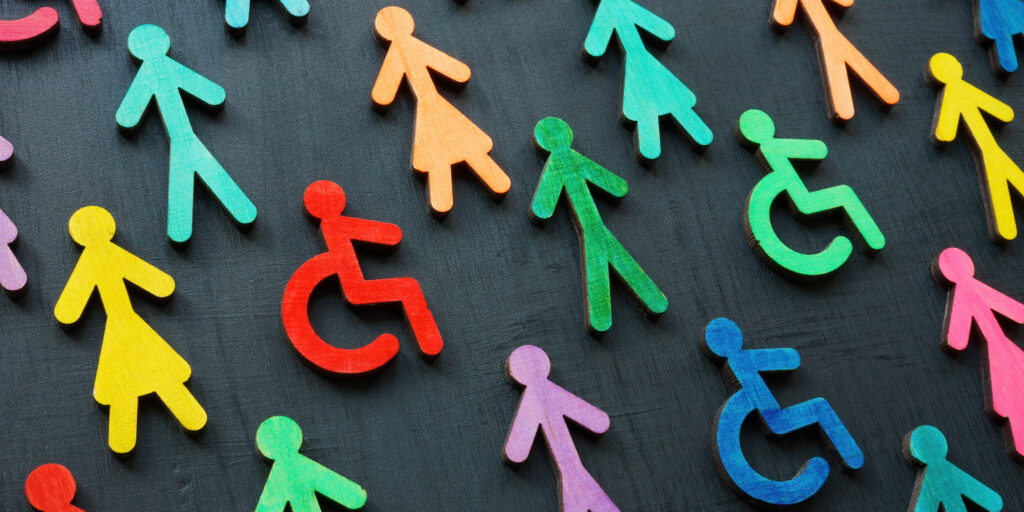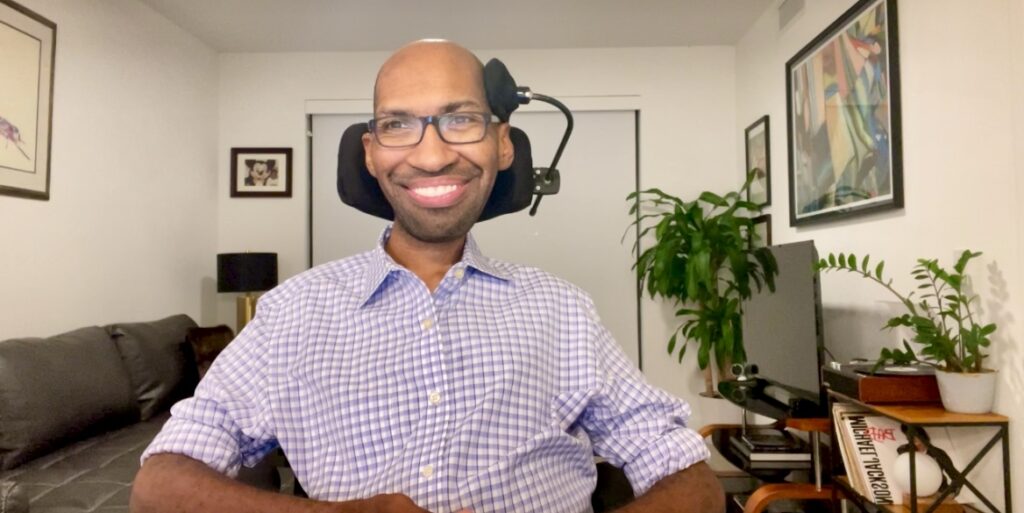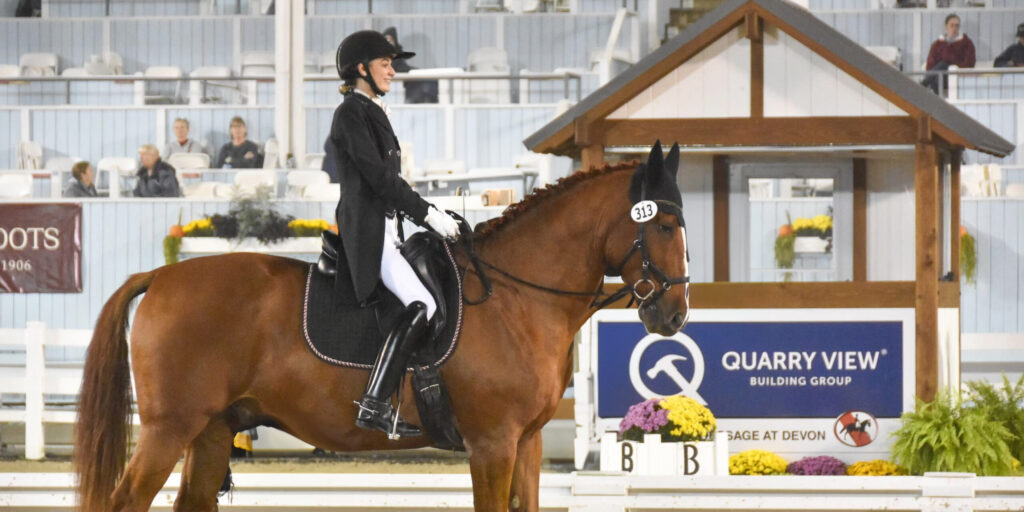
Elite Para-Dressage Athlete is Ready to Ride to Victory
By Rebecca Hume | Monday, August 18, 2025
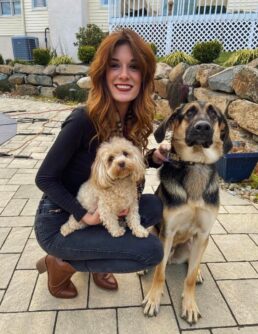
Para-dressage athlete, Riley Garrett
Riley Garrett has found her passion and purpose as a para-dressage competitor and through coaching and empowering other young athletes to challenge themselves and pursue their dreams. Born with Bethlem myopathy, the 25-year-old elite equestrian athlete is already a national and international standout in the para-equestrian dressage arena. And now she is gearing up to pursue one of her biggest dreams: securing a spot on the 2028 U.S. Paralympics Team.
Falling in love with the dance
The equestrian sport of dressage is most often described as horse ballet. The choreographed movements of the rider and horse together demonstrate the horse’s training and athleticism while spotlighting the education and skillset of the rider.
“It’s communication between the horse and the rider, very subtle and very intentional, coming from your seat, your breath, your posture, and entire biomechanics and anatomy,” Riley says. “We speak to the horse without words. It’s an elegant discipline. I have been studying this and biomechanics for 15 years now.”
In fact, Riley is one of the earliest riders in the para-dressage arena. Through the early tutelage and mentorship of two legendary equestrian greats and pillars in the paralympic community, Riley has been honing her craft and helping to build an incredible program since she was a toddler.
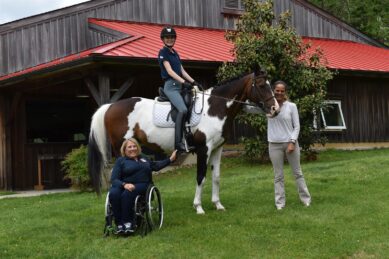
Riley at Thorncroft with Hope Hand, Vinnie the horse, and Vinnie’s owner, Caroline Moran
Riley fell in love with horses while spending time with her grandmother in Saratoga Springs, New York, as a young child. That love evolved into her love of dressage after meeting her grandmother’s best friend, Hope Hand, who was the President of the United States Para-Equestrian Association. Riley began riding at the Thorncroft Equestrian Center and quickly connected with her mentor, Carole Laulis, Vice President of the United States Para-Equestrian Association.
“Hope and Carole raised me at Thorncroft. What started as therapy to keep my mobility and range of motion turned into a sport for me,” Riley says. “I started my competitive journey when I was 13 years old. I watched the Selection Trials in Rio and said that is what I want to do. I have been competing internationally since I was 15 and have competed in over 100 para-dressage competitions, including more than 10 three-star international competitions.”
Riley, who was shortlisted for the Tokyo 2021 Paralympics, is a recipient of the Lloyd Landcramer Memorial Sportsmanship Award, and authored Building the Para Dressage Pipeline for Equestrian Magazine, has been making a name for herself as a top-tier athlete – and as an advocate for para-dressage inclusion and recognition.
Adapting for excellence
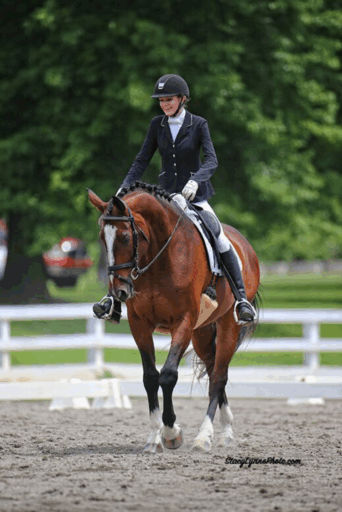
Riley training and connecting with her horse, Quasi Cool.
“The para-dressage aspect is parallel to able-bodied dressage. We have adaptive aids that make us parallel to the able-bodied rider. If I can’t use my right leg to communicate with my horse. I am going to use a whip as my leg and I now have this equality that an able-bodied person would have,” Riley says. “Para is so incredible because it’s not about what you can’t do, it’s about what you can do. We get so creative because no matter the ability in the position, we can succeed. It’s a way to express and communicate even if your body can’t.”
Living with Bethlem myopathy, Riley experiences muscle fatigue, pain, contractures, and weakness. She occasionally uses a cane, especially during periods of increased fatigue. Her young service dog, Henry, is already proving to be a lifesaver in helping to prevent falls and is in training to support her more fully as her progressive condition advances. Riley’s father and two siblings share her diagnosis, and she was raised in a home where disability was never a reason not to do something. She grew up with the mindset that navigating life with a neuromuscular disease is about figuring out accommodations and adaptations to parallel the physical motions that might be challenging – just like in para-dressage.
“I always thought that even if I can’t walk as fast, I can still keep up. But really believing those words is a different conversation. The sport, the competition, even this disease, gave me the strength to fight and keep fighting even when I thought I couldn’t,” Riley says. “You find it in your soul to keep going and figure it out. Finding that worthiness, that advocacy in yourself when someone says you can’t, and believing you can. It then becomes your version of normal – and that is enough. I have learned that I am so much stronger than I gave myself credit for.”
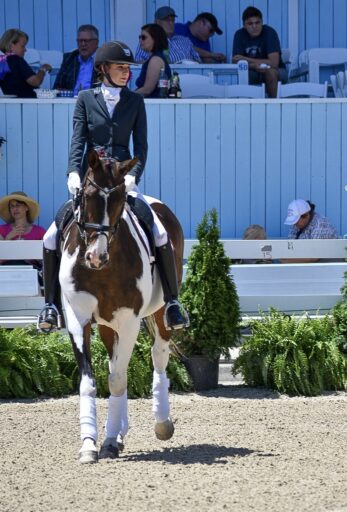
Riley competing in a para-dressage event.
Riley uses rubber bands to help keep her feet in the stirrups, as contractures in her hamstrings prevent her from dropping her heels, making it easy for her feet to slip out during movement. She uses two whips if her legs get tired, each whip acting as an extension of her leg and countering the muscle fatigue common to her diagnosis. She also uses a looped rein to increase control and provide a consistent place for her hands, which also have muscle contractions.
She wears an orthotic appliance, similar to a retainer, that is designed to relieve temporomandibular joint (TMJ) pain and support proper airway function. This holistic, non-invasive therapy helps stabilize the muscles in the jaw, neck, and head, promoting better alignment and breathing. It’s a cutting-edge approach that high-level athletes are increasingly beginning to adopt for improved performance and recovery.
“When you get tired or start experiencing pain, you tend to clench your jaw,” Riley explains. “The appliance works by gently separating the jaw joints, preventing that clenching. As a result, your jaw and airway stay more open and stable, which, in turn, helps regulate your entire nervous system. I was previously unable to stabilize my right shoulder. I went through treatment and use my appliance, and now I can. It is an incredible aide and is very new, but it is so effective.”
Riley first learned about this new method working with a team of doctors through TMJ International, she specifically mentions Dr. Steven Olmos, Dr. Kristina Wolf, and Dr. Thomas Sims as having a tremendous impact on her journey. Riley learned how this method could positively impact complex cases like hers, involving muscular dystrophy and sports performance, and how to advocate for access to care. Now, Riley’s success serves as a real-life example at medical conferences, demonstrating how the airway-centered, holistic approach can make a significant difference, even in challenging cases. Her experience has opened the door to future conversations about how this approach could help others with neuromuscular disease.
Chasing her dream
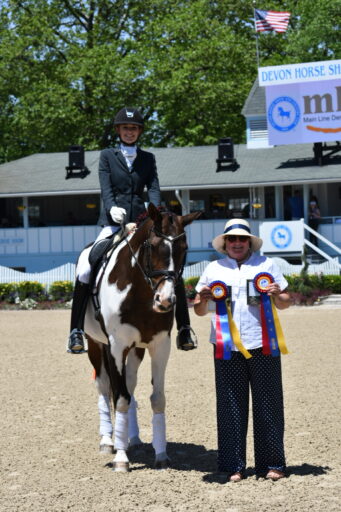
Riley, Vinnie the horse, and Carole Laulis
For an athlete of Riley’s caliber, the Paralympics are the pinnacle of championships in the para-dressage world. Her potential candidacy to compete for Team USA at the Los Angeles 2028 Paralympics Games has been years in the making. Unlike other sports that require a cut-and-dry tryout or final competition, dressage teams are determined by invitation status and judge observation over years of competition. Para dressage uses a grading system from I to V to classify athletes based on the severity of their impairments, with Grade I representing the most significant impairment and Grade V the least.
“You are going out and campaigning at different venues with your horse every weekend to compete in front of judges, basically competing against yourself because you win by doing better,” Riley says. “The judges score using percentages and you need certain percentages to qualify for higher competitions. You want to be recognized and invited to ride at higher level championships. If you do well then you can compete internationally and if you do really well at an international level then you can be selected to ride for elite teams, like Team USA.”
A large part of that journey for a para-rider is solidifying and finalizing their partnership with their horse. Riley is currently trialing and training with Quasi Cool, a former eventer and cross-country horse. “This is a second opportunity for the horse and for me,” Riley says. “I was short listed for the Paralympics last time and it didn’t happen. Quasi is learning para-dressage and just trying to figure out how to work with me and my disability. The partnership is going really well.” Quasi is the narrowest horse that she has ever trained with, which is a huge advantage given her muscle and balance challenges, especially because sitting with widened hips can be difficult for her. “He’s truly special in a way words can’t fully capture,” Riley says.

Riley and Quasi Cool.
The second hurdle to secure a place on the US para-dressage team, which typically includes four primary riders and two alternates, is to impress the US Para-Dressage High Performance Coach, Michel Assouline. Campaigning for a spot involves submitting videos and demonstrating a strong partnership between rider and horse to earn invitations to elite training camps and selection trials. From there, the journey continues through multiple qualifying competitions, with the 2026 FEI World Equestrian Games in Aachen, Germany, serving as a key milestone. This event offers Riley the chance to showcase her talent on the international stage and strengthen her bid for selection to the US team for the 2028 Los Angeles Paralympic Games.
Making an impact for growth
As Riley gears up for her biggest competitions yet, she is also using her platform and prestige to advocate for increased inclusivity. As one of the first people involved in the para-dressage industry from the beginning and witness to growth and development of the sport over the years, Riley is committed to contributing to that growth and increasing inclusion of the para-community. That commitment honors the mission that Hope started so many years ago.
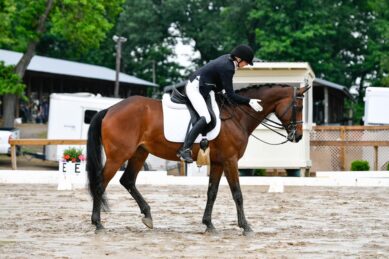
Riley and Quasi Cool at a competition.
“Watching para dressage grow over the years has been incredible,” Riley says. “For a long time, the United States Dressage Federation (USDF) didn’t fully integrate para dressage into their core programs, but we’ve made significant progress in breaking down those barriers. Now, para-athletes are increasingly included in USDF-sanctioned competitions, and this year marks one of the first times the Para-Dressage Championship is held alongside an able-bodied championship. It’s a huge step forward. This inclusion is especially inspiring for young riders with disabilities. I keep telling them—they can do this. They can do anything!
Riley’s actions and goals model that she truly practices what she preaches. In addition to pursuing her position on Team USA, coaching, and working full-time as the Head of Business Development and Communications for Anchor Corps Digital Marketing (specializing in the medical division), she is committed to changing the way that the world views para-riders – including advocating for the opportunity to sit as a judge.
“To my knowledge, there has never been a para-dressage athlete certified as a judge for able-bodied competitions,” Riley says. “So, I started that conversation. My brain works just like anyone else’s—I want to go through the judges’ program and earn that seat at the table. The current path requires riding through every level to qualify, which can be limiting for riders like me with physical restrictions. As a Grade III para-athlete, I may not meet the traditional requirements to physically ride every test, even though I can study, analyze, and understand the sport at the highest level. That’s the challenge I’m determined to work through—because para riders deserve that representation in the judge’s box too.”
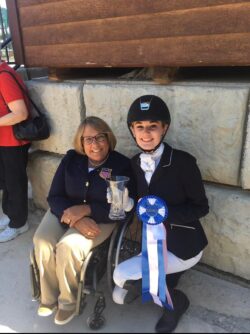
Hope and Riley.
As Riley vies for a spot on Team USA and a seat at the table, her advice to others living with a disability is simple: do not stop chasing your dreams. “Do not give up. You are not different or less than because of your disability, even if that might be what society or culture tries to drive into our brains,” she says. “Our version of normal is always enough. We are enough. Know in your heart and soul that you are enough and don’t let anyone get in the way or stop you from going after your goals. There might be an adaptation, and that is okay. Finding that strength and equality to make it work, you can do anything you want to do.”
Next Steps and Useful Resources
- Stay up-to-date on Quest content! Subscribe to Quest Magazine and Newsletter.
- Follow Riley’s journey here.
Disclaimer: No content on this site should ever be used as a substitute for direct medical advice from your doctor or other qualified clinician.


